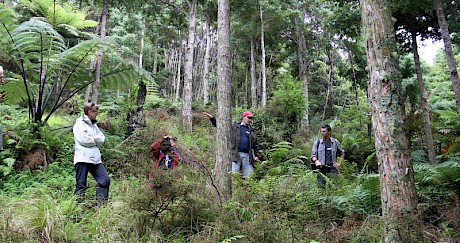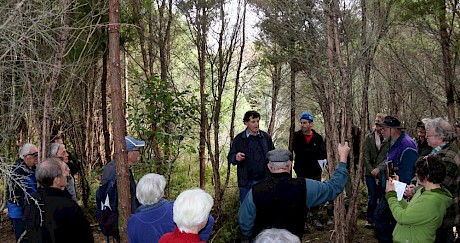Kanuka (Kunzea ericoides)
Note: The uses of kanuka and manuka (Leptospermum scoparium) are somewhat interchangeable although manuka does not grow very large and most larger wooden items would have been made of kanuka. Manuka probably has more uses in the pharmaceutical area.
History
The Maori used kanuka for a wide range of uses, particularly those requiring a hard, strong timber. It was the most favoured wood for the making of agricultural implements –mainly different types of digging sticks. Another important use was for weapons – taiaha, tewhatewha, and koikoi (a double pointed spear). The bark was often used as an insulating material between the inner and outer walls of whare, especially in the Wanganui area. Of course kanuka is the premier fuel wood in New Zealand and, being readily available and regenerating easily, was greatly used by both Maori and European. It is likely that it was the main fuel used in Auckland and would have been carted quite long distances. For example, in the diary of T. Harris, Sir George Grey’s manager on Kawau Island, he notes that kanuka fire wood was shipped from Sir George’s property to Auckland at the rate of 40 tons per month. Other European uses were as house blocks, fencing and wheel spokes but with indifferent results. There is now renewed interest in its use for impact handles.
Medicinally the leaves can be used to make a ”tea” which, when strong, has emetic qualities; when weak it can be a replacement for conventional tea. The shoots and capsules when chewed will relieve dysentery while the inner bark can be boiled and used as a mouthwash and to treat mouth and eye troubles.
Distribution
Kanuka is found throughout the North and South Islands but mainly on forest margins. It acts as a nurse plant for many species - especially kauri and Podocarps - and, being light demanding, is eventually replaced by these species.
Tree size and growth
Size according to most authorities is up to 15 metres tall and 60 cm diameter. However on some sites it will grow up to 25 metres, when drawn up by other species. Diameters in excess of 130 cm have been recorded. Growth is quite fast, up to one metre height annual when young, however the species tends to be multi-stemmed from the ground so, if being managed to produce single stems, needs to be close spaced initially and pruned if required. Best growth seems to be on easy slopes and high river terraces, it does not grow well on wet sites and hard clays, giving way to manuka in this situation.
Timber
Timber characteristics, with P radiata figures shown in brackets for comparison, are as follows: -
Density (green) ? kg/ m³ (930 kg m³)
“ (dry) 757 kg/ m³ (500 kg/m³)
Tangential shrinkage -green to 12% m. ? (4.7%)
Radial shrinkage ? (2.2%)
Modulus of rupture 127 Mpa (90 Mpa)
Modulus of elasticity 12.5 Gpa (9 Gpa)
Only northern and southern rata, black maire, puriri and probably pohutukawa are denser than kanuka, while kowhai, southern rata, hard beech and rewarewa are stronger. The wood is hard, heavy and finely textured but it is slow to dry and prone to checking. It is not ground durable.
Potential
Kanuka is a multi purpose species and can be used in the following ways: -
- As a nurse for kauri and podocarps, it can be managed for removal as firewood or better stems retained for timber production.
- It can be grown for the production of honey and essential oils (mainly p-cymene and a-pinene). Kanuka yields more oil than manuka.
- It can be grown for timber.
Research requirements
Research is needed into most aspects of kanuka establishment although it is fairly easy to handle and solving problems here should not be difficult. Of greater difficulty will be the establishment and management of kanuka plantations for oil production on a commercial basis and on growing it for specialist timber production. Crop & Food Research have done considerable work on oil production but, as far as is known, have not attempted to establish production plantations.
References
- Allan H H. 1961. Flora of New Zealand Vol. 1 Government Printer Wellington
- Brooker S G, Cambie R C & Cooper R C 1981. New Zealand Medicinal Plants. Heinmann
- Burstal S W & Sale E V. 1984. Great Trees of New Zealand
- Clifton N C. 1990. New Zealand timbers
- Crop & Food Research. 2000. Essential oil production from kanuka and manuka. Broadsheet No. 116. www..crop.cri.nz/home/products-services/publications/broadsheets/essentialoilmanuka_kanuka.pdf
Species profile by Ian Barton


